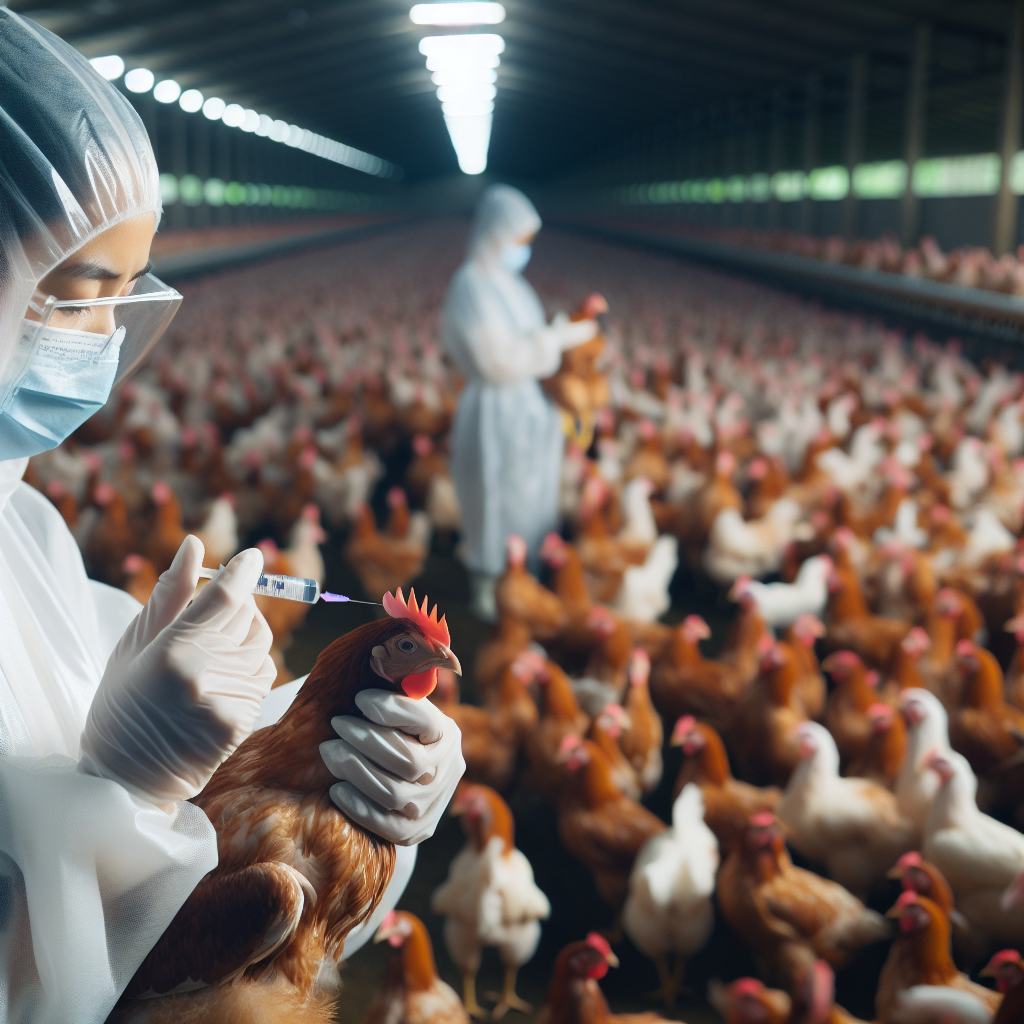In the vast and ever-evolving world of farming practices, the welfare and humane treatment of chickens has become a pressing concern. With different regions around the globe establishing their own regulations, it is fascinating to explore how these laws aim to protect these feathered creatures. From ensuring adequate living spaces to monitoring slaughter methods, regional regulations strive to create a humane environment for chickens. Join us as we delve into the intricate web of regulations and discover the diverse ways in which different regions address the welfare and treatment of these beloved farm animals.
Overview of Regional Regulations on Chicken Welfare
When it comes to the well-being and humane treatment of chickens, regional regulations play a crucial role in ensuring that these animals are provided with a safe and healthy environment. These regulations outline the legal frameworks, minimum standards, and guidelines for various aspects of chicken welfare, such as housing and living conditions, healthcare, feeding, transportation, and humane slaughter. By examining the different facets of regional regulations, we can gain a comprehensive understanding of how governments and international bodies work together to protect the welfare of chickens.
Legal Frameworks for Chicken Welfare
National Legislations
At the national level, governments enact legislations to protect and promote the welfare of chickens. These legislations vary from country to country and often consider factors such as the type of chicken production (e.g., egg-laying hens or broiler chickens), the scale of production, and cultural practices. National legislations might include requirements for minimum space allowances, temperature and lighting regulations, feeding and nutrition standards, as well as rules for transportation and handling.
International Agreements and Standards
In addition to national legislations, international agreements and standards provide a framework for regulating chicken welfare across borders. Organizations like the World Organisation for Animal Health (OIE) and the Food and Agriculture Organization of the United Nations (FAO) collaborate with member countries to establish guidelines and recommendations. These international agreements aim to harmonize animal welfare practices and ensure that chickens are treated humanely regardless of their geographic location.
Minimum Standards for Chicken Welfare
Housing and Living Conditions
One of the key areas for chicken welfare regulations is the housing and living conditions provided for these animals. Regional regulations often specify the minimum space requirements for each chicken, taking into account their physiological and behavioral needs. This ensures that chickens have sufficient room to move and engage in natural behaviors. Regulations may also address aspects like ventilation, flooring, nesting materials, and access to outdoor areas for free-range production systems.
Healthcare and Veterinary Care
Keeping chickens in good health is vital for their overall welfare. Regional regulations prioritize healthcare and veterinary care for chickens by requiring regular inspections, vaccinations, and disease prevention measures. These regulations may also specify the qualification and training of personnel responsible for chicken health management. By addressing healthcare needs, regional regulations work towards minimizing the risk of diseases and improving the overall well-being of chickens.
Feeding and Nutrition
Proper feeding and nutrition play a crucial role in ensuring good chicken welfare. Regional regulations aim to establish guidelines for feed composition, quality, and access to water. They may address factors like the frequency and quantity of feeding, as well as the use of additives or medication in feed. By setting specific standards for feeding and nutrition, these regulations help maintain the health, growth, and productivity of chickens.
Lighting and Temperature Regulations
Lighting and temperature are essential factors that significantly affect the welfare of chickens. Regional regulations often provide guidelines on the duration and intensity of lighting, taking into consideration the natural daylight cycle. They also address temperature requirements, particularly in poultry houses, to ensure that chickens are kept within a suitable range that promotes their well-being. By providing regulations for lighting and temperature, regional authorities are actively working towards creating a conducive environment for chickens.
Transportation and Handling of Chickens
Transportation Guidelines
Transportation of chickens from farms to processing plants or other destinations is an aspect that requires careful regulation to minimize stress and ensure the welfare of these animals. Regional regulations often outline specific guidelines for the transportation of chickens, addressing factors such as vehicle design, loading density, duration of transportation, and climatic considerations. These guidelines aim to prevent injury, discomfort, and excessive stress during transit.
Handling Practices
Proper handling of chickens is crucial to ensuring their welfare, whether during routine management or when moving within farm premises. Regional regulations often set forth guidelines for handling practices, like the appropriate methods for catching, carrying, and restraining chickens. These regulations emphasize the need for gentle handling techniques to avoid causing distress, fear, or physical harm to the birds. By promoting good handling practices, regional authorities prioritize the welfare of chickens throughout their various interactions with humans.
Methods to Ensure Humane Slaughter
Species-Specific Slaughter Methods
The humane slaughter of chickens is an essential consideration in regional regulations. Different species of chickens may require specific slaughter methods to minimize pain and distress. Regional regulations take into account the anatomy and behavior of chickens, prescribing appropriate methods such as controlled atmosphere stunning or electrical stunning. By implementing species-specific slaughter methods, regional authorities aim to ensure that chickens are treated with respect and care during the final stage of their production cycle.
Animal Welfare at Slaughterhouses
In addition to specifying slaughter methods, regional regulations also address animal welfare at slaughterhouses. These regulations encompass aspects like stunning effectiveness, monitoring of welfare indicators, and training requirements for slaughterhouse staff. Regional authorities often conduct inspections and audits to ensure compliance with welfare standards during handling, stunning, and slaughter. This emphasis on animal welfare at slaughterhouses reflects the commitment of regional regulations to uphold the dignity and well-being of chickens until their final moments.
Laying Hen Regulations
A specific area of focus within regional regulations is the welfare of laying hens, as they have unique needs and requirements. These regulations often stipulate the minimum space allowances per hen, the provision of nest boxes, perches, and dust-bathing areas. They may also address the management of molting, beak-trimming practices, and the use of enriched cages or alternative housing systems. By providing dedicated regulations for laying hens, regional authorities acknowledge and address the specific welfare concerns of these chickens.
Broiler Chicken Regulations
Broiler chickens, raised primarily for meat production, are also subject to specific regulations aimed at ensuring their welfare. Regional regulations often include guidelines on space allowances, growth rates, feed formulas, and the use of antibiotics or growth-promoting substances. They may restrict certain practices, such as the use of fast-growing breeds that may lead to welfare issues. By implementing comprehensive regulations for broiler chickens, regional authorities emphasize the importance of their welfare throughout their rapid growth period.
Enforcement and Inspection Systems
Government Agencies
To ensure compliance with chicken welfare regulations, regional governments establish enforcement and inspection systems. Government agencies are responsible for monitoring and enforcing adherence to the regulations. Inspectors visit farms, slaughterhouses, and transport facilities to assess compliance, identify potential issues, and recommend corrective actions. Deterrent measures, such as penalties or the revocation of licenses, may be imposed on non-compliant entities. By establishing robust enforcement and inspection systems, regional authorities work to ensure that chicken welfare regulations are effectively implemented.
Third-Party Certification
In addition to government agencies, third-party certification programs play an important role in verifying and ensuring compliance with chicken welfare regulations. These certifications are often voluntary and provide an additional layer of reassurance for consumers and businesses. Independent auditors assess farms, slaughterhouses, and other relevant facilities against recognized welfare standards, certifying those that meet or exceed the requirements. Third-party certification programs contribute to a culture of transparency and accountability, further promoting the welfare of chickens across regions.
Future Directions and Potential Improvements
As our understanding of chicken welfare continues to evolve, regional regulations must adapt and improve to address emerging concerns and scientific advancements. Future directions may include advancements in housing systems, such as the development of innovative free-range setups or welfare-friendly cage alternatives. Additionally, efforts might focus on reducing the environmental impact of chicken production, exploring alternative feed sources, and further enhancing the training and education of stakeholders involved in chicken rearing and handling. By constantly seeking improvements, regional regulations can continue to prioritize the welfare and humane treatment of chickens in the future.
In conclusion, regional regulations play a vital role in addressing the welfare and humane treatment of chickens. These regulations cover a wide range of areas, including housing, healthcare, transportation, slaughter, and the welfare of specific chicken types such as laying hens and broiler chickens. By setting minimum standards, providing guidelines, and establishing enforcement systems, regional authorities are working towards ensuring that chickens are treated with respect and care throughout their lives. The coordination between national legislations and international agreements further strengthens the commitment to chicken welfare across borders. As we move forward, it is essential to embrace future directions and potential improvements to ensure the continuous advancement of chicken welfare regulations and the well-being of these animals.




